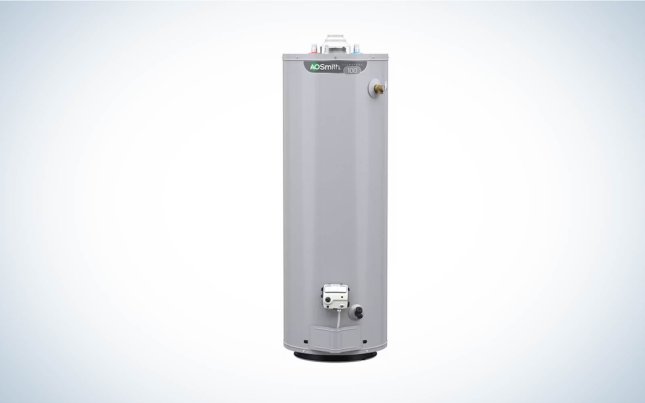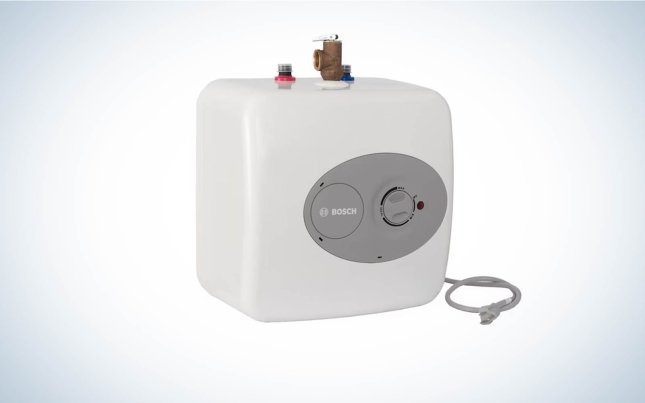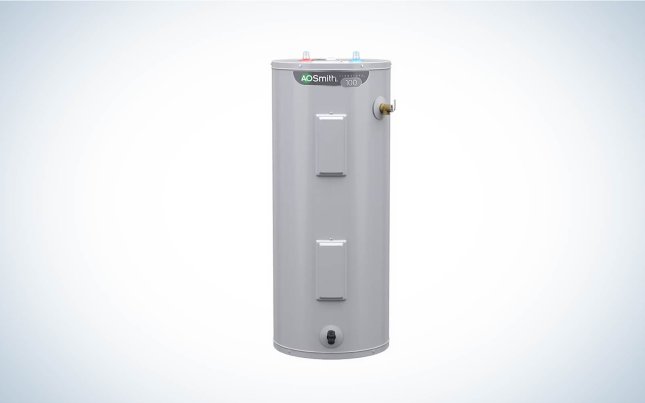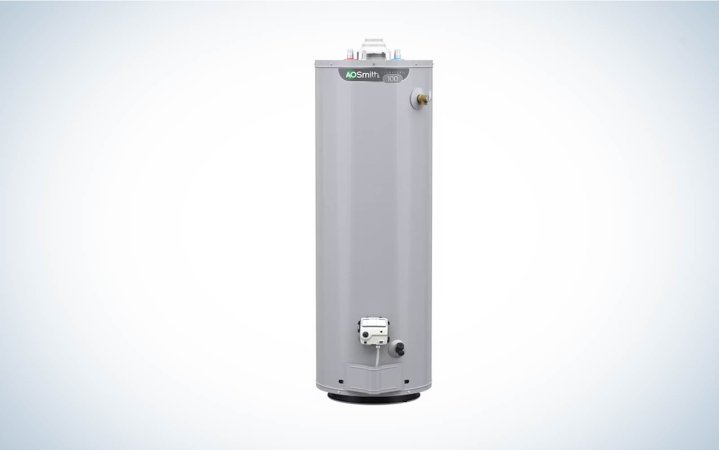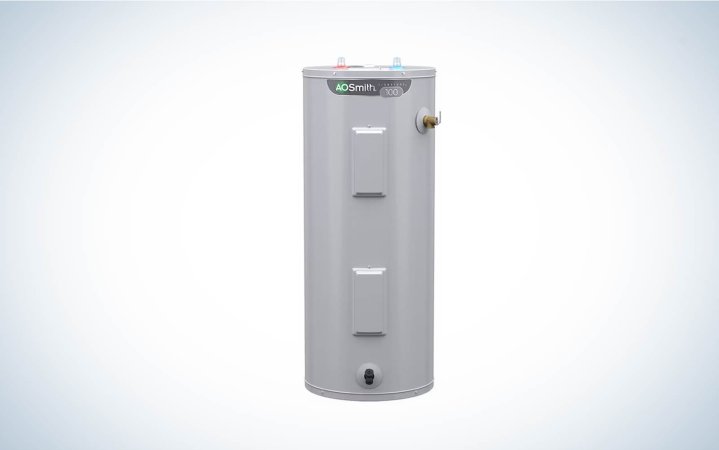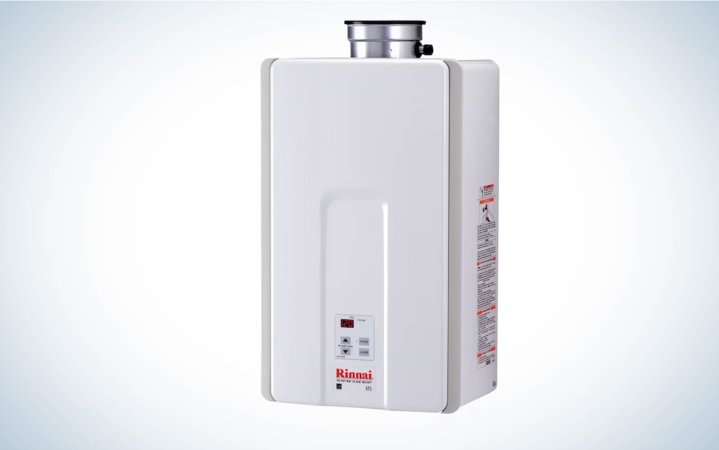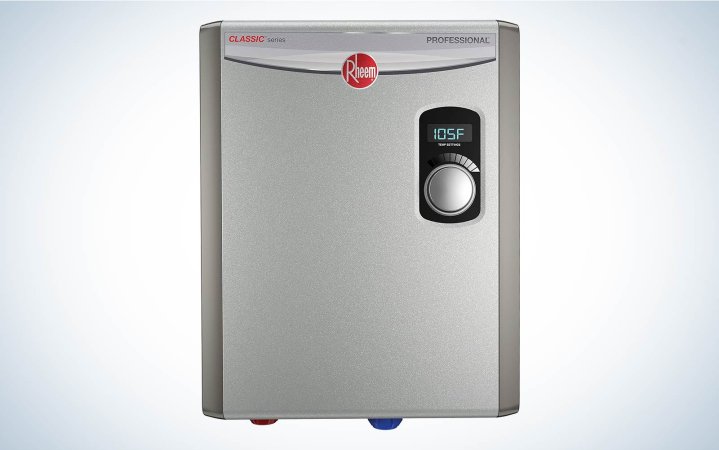We may earn revenue from the products available on this page and participate in affiliate programs. Learn more ›

Water heaters accomplish a simple but essential job: They provide the home with direct access to hot water. The cold water service for the home flows into the water heater, where it is heated and then sent out to the various sinks, showers, and water-using appliances throughout the dwelling. That part is simple, but choosing the right water heater for your needs and space isn’t quite as straightforward. Homeowners can get instant hot water with a tankless water heater or store hot water for future use with a tank-style water heater. Picking one can get complicated, but this list of the best water heaters can help get the right model for your home and lifestyle.
- Best overall: A. O. Smith Gas Tank Water Heater
- Best value: Bosch Tronic Point-Of-Use Water Heater
- Best electric: A. O. Smith Electric Tank Water Heater
- Best gas: Rinnai Natural Gas Tankless Water Heater
- Best tankless: Rheem 18kW 240V Tankless Electric Water Heater
How we chose the best water heaters
Selecting a list of the best water heaters started with extensive research into a variety of products before the pool of potential appliances could be pared down. To eliminate products from the running, it was necessary to examine each water heater while considering the product specs and how they compared to other water heating appliances.
Top considerations include the type of water heater, fuel type, dimensions, flow rate of tankless water heaters, and the tank capacity of tank-style water heaters. Additionally, the availability and cost were assessed alongside these product specs to find the best water heaters across several categories. This list of the best water heaters was finalized only after researching and comparing the pool of potential products to select the top water heaters and eliminate the appliances that didn’t measure up.
The best water heaters: Reviews & Recommendations
Tankless water heaters are smaller than tank-style options, allowing them to be installed in tight spaces where a tank water heater could not. These water heaters provide instant access to hot water, though they may not be able to keep up with the demands of a large family. Tank-style water heaters have an element at the base of an insulated tank to heat the water. The tank keeps the water hot until it is needed. However, if all the hot water stored in the tank is used, then it can take about 20 minutes for the new water in the tank to heat up. While each specific product has its intended audience, it’s worth perusing all of the options as there’s always overlap, and multiple models may fit your needs.
Best overall: A. O. Smith Gas Tank Water Heater
A. O. Smith Gas Tank Water Heater
Why it made the cut: Homeowners won’t need to worry about running out of hot water quickly with this bulky 50-gallon gas water heater.
Specs
- Type: Tank
- Fuel: Natural Gas
- Dimensions: 22 inches diameter by 60.75 inches height
- Capacity: 50 gallons
Pros
- Large 50-gallon capacity
- 40,000-BTU gas burner
- Self-diagnostic electronic gas control and LED status indicator
- Certified for use at high altitudes up to 10,100 feet
Cons
- Bulky weight is difficult to maneuver at 165 pounds
While tankless water heaters will heat the water as it passes through the appliance, tank-style water heaters, like this appliance from A. O. Smith, store a large amount of hot water for future use. This A. O. Smith gas water heater has a large capacity storage tank that is capable of storing up to 50 gallons of water.
This tank-style water heater uses natural gas and a 40,000-BTU gas burner to heat up the tank’s contents. Gas water heaters can be more expensive than electric water heaters, though the cost of natural gas tends to be less than the cost of electricity, so these appliances are often more affordable in the long term. This appliance can also be used in locations that are high up in the mountains, with a certification for altitudes up to 10,100 feet.
Additionally, the gas water heater has a built-in self-diagnostic system that monitors the electronic gas control and uses an LED status indicator to communicate the system’s operational status. For added protection, this model also has a built-in safety system that reduces the risk of accidental flammable vapor ignitions. However, before investing in this unit, it’s important to measure the space and compare it against the product dimensions to ensure that the appliance will fit in the designated area.
Best value: Bosch Tronic Point-Of-Use Water Heater
Bosch Tronic Point-Of-Use Water Heater
Why it made the cut: Get hot water directly at the sink or shower with this 2.7-gallon point-of-use water heater.
Specs
- Type: Point-Of-Use
- Fuel: Electric
- Dimensions: 10.75 inches depth x 13.75 inches width x 13.75 inches height
- Capacity: 2.7 gallons
Pros
- Lightweight design is easy to lift, hold, and position
- Small size is suitable for installing under the sink or counter
- Mountable design for floor or wall mounting
- Instant access to hot water where it’s needed
Cons
- Small capacity
- Not suitable for whole-home water heating
Whole-home water heaters are the most common option for heating incoming cold water, but homeowners can also invest in a point-of-use water heater, like this Bosch Tronic model. This point-of-use water heater can work independently of the primary water heater for the home to provide hot water to a single faucet or shower, but it can also be set up to work in line as a backup for the primary water heater during busy periods throughout the day, like the morning or evening.
The small size and lightweight design make this water heater easy to carry and maneuver into position during installation. However, this also means that the water heater has a relatively small storage capacity of just 2.7 gallons, so it isn’t a good option for extended use or whole-home water heating. Mount the water heater on the floor, the wall, under the sink, or under the counter with the included mounting brackets.
Best electric: A. O. Smith Electric Tank Water Heater
A. O. Smith Electric Tank Water Heater
Why it made the cut: Heat 62 gallons of water in the first hour of use with the two 4,500-watt copper heating elements.
Specs
- Type: Tank
- Fuel: Electric
- Dimensions: 20.5 inches diameter by 59 inches height
- Capacity: 50 gallons
Pros
- Large, 50-gallon capacity
- Two 4,500-watt copper heating elements
- Can heat up to 62 gallons of water in one hour
- High energy efficiency and easy-to-use adjustable thermostat
Cons
- Bulky 125-pound weight
This electric water heater by A. O. Smith has a large storage tank that can hold up to 50 gallons of water. The appliance uses non-CFC polyurethane foam insulation and factory-installed heat trap nipples to reduce heat loss and greatly improve the operating efficiency of the unit. The storage tank has a slim profile that fits into tight corners with only a 20.5-inch diameter and 59-inch height.
Despite the tall, narrow shape, this electric water heater is capable of heating 62 gallons of water in an hour by using the two 4,500-watt copper heating elements. These elements provide superior heating power to shorten the time it takes to heat the incoming cold water. Users can set the ideal water temperature using the built-in adjustable thermostat located on the body of the water heater. However, due to the size and weight of the water heater, it’s recommended to have at least two people when moving it into position.
Best gas: Rinnai Natural Gas Tankless Water Heater
Rinnai Natural Gas Tankless Water Heater
Why it made the cut: Get instant access to hot water on demand at any sink, shower, or water-using appliance in the home with this tankless water heater.
Specs
- Type: Tankless
- Fuel: Natural Gas
- Dimensions: 9.25 inches depth x 14.05 inches width x 22.95 inches height
- Capacity: 7.5 gallons per minute
Pros
- Compact size doesn’t take up a lot of space
- Built-in temperature lock
- Easy-to-read digital control panel
- On-demand hot water up to 7.5 gallons per minute
Cons
- Requires venting to the outside of the home
The main benefit of a tankless water heater is that users don’t need to wait for the water to heat up. Instead, this tankless water heater can warm 7.5 gallons of water per minute, providing the entire home with on-demand access to hot water. Also, due to the built-in temperature lock, homeowners don’t need to worry about kids or other home residents changing the temperature on the water heater.
While tank-style water heaters may take up an entire corner of a room, the compact size and shape of this tankless water heater make it easier to find space for the installation. However, the Rinnai gas tankless water heater operates using natural gas, so during the installation of this appliance, the plumber or installer will need to run venting to the outside to ensure that the exhaust does not build up inside the home.
Best tankless: Rheem 18kW 240V Tankless Electric Water Heater
Rheem 18kW 240V Tankless Electric Water Heater
Why it made the cut: This tankless electric water heater features flow control and self-modulation technology to improve energy efficiency.
Specs
- Type: Tankless
- Fuel: Electric
- Dimensions: 3.5 inches depth x 14.5 inches width x 18.5 inches height
- Capacity: 4.4 gallons per minute
Pros
- Compact size for easy installation
- On-demand hot water access
- Ideal for small homes with one or two people
- Flow sensor modulates energy consumption to meet hot water demands
Cons
- Only supplies one or two fixtures simultaneously
Big, tank-style water heaters can be a great choice for large homes and big families with a high water demand. But these tank-style appliances take up a lot of space and aren’t really necessary when there are only a few people living in the home. With this in mind, the Rheem tankless electric water heater is an excellent alternative for homes with one or two people. The Rheem water heater has a built-in flow sensor and self-modulating technology that automatically modifies the amount of energy consumption to meet hot water needs.
This tankless water heater provides the home with on-demand access to hot water at any faucet, shower, or water-using appliance, so users no longer need to wait for hot water. However, it should be noted that this water heater can only supply one or two fixtures simultaneously, so it isn’t a good idea to take a shower while running the clotheswasher or dishwasher.
Things to consider when buying a water heater
Before purchasing a new water heater for the home, it’s important to gain a basic understanding of the types available, as well as the key factors that can affect the efficiency and operation of the appliance. Consider the type of fuel, the size of the water heater, and the capacity to determine the best water heater to meet your needs.
Type
The first factor to consider when looking into new water heaters is the type of model that would work best for the home. Traditional tank-style water heaters have commonly been used in homes in the past, but tankless options are quickly growing in popularity. Point-of-use water heaters provide another option for homeowners who don’t want to run out of hot water while showering or washing dishes.
Tank-style water heaters are the standard option for a home. Cold water runs into the water heater and is then heated up and stored in a large insulated storage tank for future use. This design ensures that there is a significant amount of hot water ready for use, but if the entire hot water supply is emptied, then users will need to wait for the cold water to be heated.
Tankless water heaters benefit from heating water as it passes through the appliance. This takes just a few seconds, allowing for on-demand hot water to the home. Additionally, tankless water heaters take up less space than tank-style. The drawback with these appliances is that they may struggle to keep up with hot water demands for a larger household, especially during the busy periods of the day.
Point-of-use water heaters can be either tank-style or tankless. The defining feature of these water heaters is that they are designed for installation at one specific faucet, shower, or other plumbing fixture. The intent is to ensure that there is always hot water available when someone wants to use the specific plumbing fixture. This can be a highly effective way to prevent the water from running cold in the middle of a shower.
Fuel
There are three main types, including electricity, natural gas, and propane.
Electric water heaters tend to be the least expensive to purchase and install, but the operating costs are typically higher due to the cost of electricity. These water heaters do not require venting, so they can be a good option if the home does not currently have existing ventilation for a gas water heater. And you could run some models off a portable power station in the event of weather that knocks out the mains.
Natural gas water heaters are a common option, though the installer may need to run ventilation lines for the exhaust. These appliances have a higher power output than electric models, allowing them to heat the water at a faster rate. However, natural gas water heaters tend to cost more to purchase and install.
Propane water heaters are less common than electric or natural gas units, but these appliances can be effective for small homes, point-of-use installations, or even for some RVs. The main issue that makes propane water heaters less appealing is that the homeowner or user needs to purchase or refill propane tanks for regular operation. But, if you already have a propane grill or a propane generator, this shouldn’t be a new experience.
Size
One of the main reasons to invest in a tankless water heater over a tank style is the size. Tankless water heaters have a compact size and shape that can fit in tight spaces where a large tank cannot. For this reason, tankless typically works better for small houses and condominiums.
Similarly, point-of-use water heaters don’t take up a lot of room, allowing them to be installed under the counter or under the sink. While a tank-style water heater does take up more space than the other water heater options, homeowners can find tank-style products with tall, narrow profiles that make it easier to install the water heater in a tight corner or small maintenance room. Just make sure to take proper measurements of the space and the water heater to ensure the unit will fit. Also, don’t forget to leave enough room for water lines, electrical connections, gas lines, and gas vents.
Capacity
For a tank-style water heater, capacity means the amount of water that can be stored inside the insulated tank. Typically, tanks range in size from about 30 gallons to 80 gallons, though most homes will have a 40- to 50-gallon capacity.
The capacity of a tankless water heater refers to the flow rate, as well as the amount of water that can be heated within a specific timeframe. Generally, the flow rate is measured in gallons per minute or GPM. Small tankless water heaters may only be able to produce three to four gallons of hot water per minute, while larger units may be capable of heating more than seven gallons per minute. For reference, faucets typically require 0.5 GPM, dishwashers require 1 GPM, washing machines require 1.5 GPM, and showers require 2 to 2.5 GPM.
FAQs
The lifespan of a water heater is heavily dependent on how well the appliance is maintained, as well as the frequency of use. On average, a water heater will last about eight to 12 years, though some can last up to 20 years before needing to be replaced.
There are a few signs that you can look out for to help determine when it’s time for a water heater upgrade. One indication that the water heater isn’t working properly is that the appliance overheats. Additionally, if the appliance struggles to heat the water in the tank or keep up with heating demands, then it may be time for a maintenance call to clean any built-up sediment out of the water heater. If this doesn’t work, you may need to consider upgrading the appliance.
When a water heater no longer heats up, it can be due to a variety of issues. Check to make sure the water heater breaker is on to ensure the unit is receiving power. If you have a gas water heater, verify that the gas valve is open and the pilot light is on. In some cases, the problem may be due to a significant sediment buildup in the bottom of the water heater. This can act as an insulating barrier, preventing the water from heating up.
Final thoughts on the best water heaters
- Best overall: A. O. Smith Gas Tank Water Heater
- Best value: Bosch Tronic Point-Of-Use Water Heater
- Best electric: A. O. Smith Electric Tank Water Heater
- Best gas: Rinnai Natural Gas Tankless Water Heater
- Best tankless: Rheem 18kW 240V Tankless Electric Water Heater
Hot water is a necessary part of everyday life. People use it to wash dishes, clean the house, do loads of laundry, sanitize household surfaces, and bathe. It can also be used simply to relax under the warm spray of the shower after a long day at work. With this in mind, a water heater is an important appliance that should be properly maintained to avoid any issues with the availability of hot water in the home.
Tankless water heaters are a suitable option for small families and small to mid-size homes. Even larger homes can benefit from the on-demand functionality of tankless water heaters, though you may need more than one unit to accommodate the water demands of the entire home. Tank-style water heaters are less expensive to purchase and can store a substantial amount of water for future use. However, when no one is home, the water heater will continue using energy to heat and reheat the tank’s contents, leading to energy waste. Consider the pros and cons of each type to decide on the best water heaters for the home.
